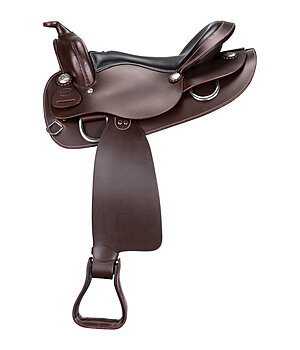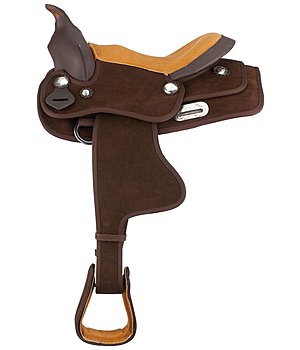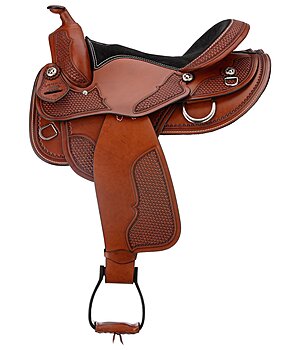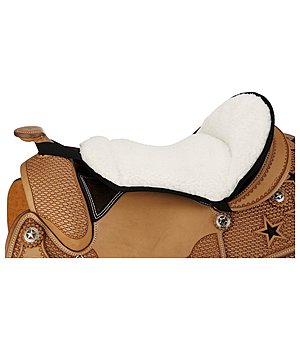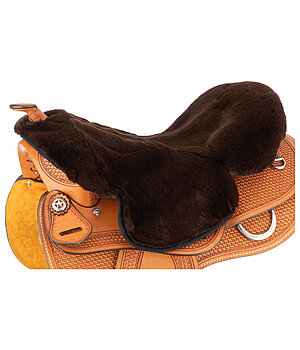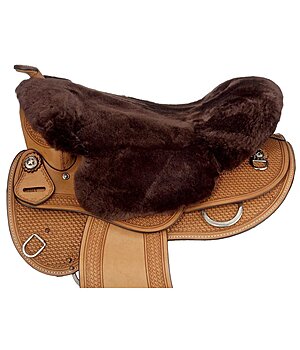What should I look for when buying a Western saddle?
The purchase of a well-fitting saddle is important for the horse’s health and further riding training, regardless of the discipline. While the adjustment possibilities of an English saddle are manifold, there are fewer options for optimising the fit of Western saddles afterwards. This makes it all the more important to be well advised when buying a Western saddle. We explain in our guidebook which things you should definitely consider when buying a Western saddle!

To ensure that nothing goes wrong when buying a saddle, professional saddle advice is particularly important. Experienced saddlers or saddle fitters have an extended knowledge of the saddle position and are a valuable investment in finding the right Western saddle for you and your horse. If it is not a custom-made saddle, it is important to find the model that comes closest to the ideal measurements for Western saddles with a standard tree. Subsequent adjustments to the saddle tree are difficult to implement in Western saddles with a ready-made saddle tree and are sometimes very cost-intensive.
In addition to professional guidance from a saddle maker or saddle fitter, it is helpful during the buying process to have the most important aspects in mind when trying on a saddle.
1. Which tree size should the Western saddle have?
The different tree size types of Western saddles serve as a first guide. The most common tree size types are as follows:
| Abbreviation | Tree size | Suitable for |
|---|---|---|
| ARAB (Arabian) | Extremely narrow tree | Small and lightweight horses |
| SQH (Semi Quarter Horse) | Narrow tree | Small horses with a steep shoulder |
| QH (Quarter Horse) | A medium-sized tree with straight bars | Horse types with flatter shoulders |
| FQH (Full Quarter Horse) | Wide tree | Strong horses with broad and rounded shoulders |
| XFQH (Extra Full Quarter Horse) | Extra wide tree | Heavy horses, with very broad shoulders |
Important!
Every saddle tree is different, so that even within the standardised tree sizes there is a multitude of individual tree shapes, just as there is no „standard back“ within a horse breed. Every horse has its own physiological characteristics which must be taken into account.
The specified tree size types result from the following measurements:
- Gullet width: The exact gullet width can only be measured directly on the saddle tree. It denotes the width of the fork from bar to bar. This is the space where your horse’s shoulder area is placed under the saddle.
- Gullet height: The gullet height tells you whether the withers have enough space under the saddle. The saddle must not rest on the withers, there must be at least a hand’s width of space.
Keyword Concho Distance And Gullet Width
Since it is not possible to determine the actual gullet width of a ready-made Western saddle by looking at the saddle tree, many people use the concho spacing as a measure for the gullet width. Please note that the positioning of the conchos is chosen freely by the manufacturers, so that there may be deviations and this can only be an approximate measurement.
2. What should be considered for the saddle tree of a Western saddle?
Every horse’s back is different. To find the right saddle for your horse, one of the most important features of a Western saddle is the shape of the saddle tree – especially the bars. In technical jargon, there are two aspects to pay attention to here: the skirt and the twist.
The skirt is the curve of the back. This varies in shape and can range from an almost straight back line to a so-called sway back. To ensure that the saddle adapts ideally to the shape of the back, you should make sure that the bars of the Western saddle also have a corresponding curve.
The twist describes the different angulation of the horse’s back starting from the spine downwards. The somewhat steeper shoulder area merges into a flatter lumbar area. The angulations should be considered accordingly from the shoulder to the back.

In addition, the spine should be free at all times during the movement. Under no circumstances should the bars be too close to the spine, otherwise contact with the spine could occur in the movement.
Treeless Western Saddles
Treeless Western saddles are often mentioned as a universally suitable solution when no Western saddle seems to fit. In general it can be said that a treeless Western saddle has the advantage that it seems to be more flexible in fitting, but the pressure distribution on the horse’s back can usually not be balanced so well, especially with inexperienced or overweight riders due to the missing tree. This in turn can lead to serious back problems for the horse.

3. Saddle length
A Western saddle has a larger contact surface than an English saddle. This is also reflected in the length of the saddle. When fitting a Western saddle, it is essential to ensure that the saddle is not too long. Both shoulder freedom and loin freedom must absolutely be given. A horse’s saddle position begins behind the shoulder blade and ends at the 18th thoracic vertebra.
The correct saddle position not only plays a major role when buying a Western saddle, but also during daily saddling. A common mistake is to place the saddle too far forward, so that shoulder freedom cannot be guaranteed despite a well-fitting saddle.

Important!
There are some saddles whose overall length extends beyond the cantle of the saddle. It is important to know that the information on saddle length refers exclusively to the saddle tree, which extends from the fork to the cantle of the Western saddle. The skirts of a Western saddle are usually slightly longer. However, they do not usually exert any pressure on the horse’s back. Nevertheless, it is important to ensure that the skirts end a hand’s breadth away from the hip bone, as otherwise pressure points can occur, especially when the saddle is in motion.
4. Seat size
The Western saddle should not only fit the horse, the rider’s anatomy should also be taken into account when choosing the seat size. If the seat is too small, the rider’s buttocks will also rest on the cantle. This in turn ensures that the seat’s centre of gravity and thus the distribution of pressure over the saddle tree on the horse’s back is no longer optimal. If the seat is too large, the rider has too little support in the saddle and the fenders no longer lie optimally, so that this has a negative effect on the rider’s overall sitting position.

The seat size for Western saddles is given in inches.
You can find a rough overview of which seat size is right for you here:
Children & teenagers: 13″-15″
Petite and small adults: 15.5″
Normal weight adults: 16″
Strong and large adults: 17″
Please note that these are average figures. Seat size should always be assessed on an individual basis.
5. Rider and individual requirements

When buying a Western saddle, you should also think in advance about what your wishes and requirements are for your saddle. Do you have competition ambitions and if so, in which Western discipline? Or are you a leisure rider and would like to sit as comfortably as possible on your hour-long hacks? If you are a beginner or returning rider, a buckskin seat might provide more support in the saddle, advanced riders usually prefer a smoother seat. But other factors such as appearance, weight of the Western saddle or even your own budget should also be considered when buying a Western saddle.
In order to find the right saddle for you and your horse, you should not do without the advice of an experienced saddler with a focus on Western saddles. However, the principle should always apply: The ideal fit for horse and rider comes first!
Western saddles
Find out which accessories you need for your new Western saddle in the next chapter of our guide!
Digression: A Western saddle for eternity?
Western saddles are made of very robust and durable leather, so that they can withstand a horse’s entire life and usually far beyond without any problems. However, the Western saddle cannot always accompany the horse throughout its entire life.

In the course of life, the horse’s back changes in many ways. Young horses build up muscles and the bone structure strengthens and changes. The amount of training and the conditions in which the horse is kept can also have a significant influence on the saddle area. While the body is being built up in the first years of life, the gradual breakdown of the musculature also occurs at some point due to the ageing process. Diseases and limited mobility can accelerate this process.
Please have the fit of your Western saddle checked by a saddle fitter at regular intervals. In case of severe changes of the horse’s back, often only a new saddle will help. In case of slight changes, a slight adjustment of the saddle by a saddle fitter or simply a different Western pad can be the solution.



